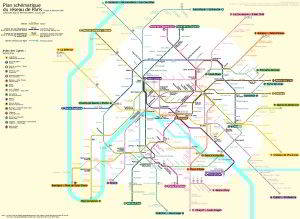The paris metro (in French, Métro de Paris) is the metropolitan rail transport system of the city of Paris, France.
Inaugurated on 19 July 1900, It is one of the oldest and most extensive metro systems in the world. It has 16 lines that extend along 226,9 kilometres (140,99 miles) and connect 208 stations. This system is operated by the Régie Autonome des Transports Parisiens (RATP).
Its design is a reflection of Parisian architecture and history, with many stations adorned with elements of Art Nouveau.
subway map
Here's the paris metro map. The most updated plan can be found on the web www.planmetroparis.net.

RECOMMENDATION: On the web TicketBar, You can save up to 20% in some bills as: Historic Paris and Notre Dame, Montmartre and the Louvre, the cruise on the river seine, etc. Generally you can buy these tickets online and you save to queue.
Websites
For more information, You can visit the following websites:
- Unofficial website of the Paris metro (Easier to use).
- Official website of the Paris metro.
- Selling tourist tickets Paris (in multiple languages).
Schedules
The Paris metro operates with the following schedules:
- Working days and holidays: of 5:30h until 1:15h.
Paris metro fares
Here is a table with the main Paris metro prices, converted to US dollars (USD) at the approximate exchange rate of 1 EUR = 1.10 USD, so that tourists can get a better idea of the prices:
| Type of ticket | Precio (EUR) | Precio (USD) |
|---|---|---|
| Ticket T+ unit | 2,15 € | 2,37 $ |
| Notebook of 10 T+ tickets | 17,30 € | 19,03 $ |
| Navigo monthly (all areas) | 86,40 € | 95,04 $ |
| Navigo weekly (all areas) | 30,75 € | 33,83 $ |
| Paris Visit 1 day (zone 1-3) | 13,55 € | 14,91 $ |
| Paris Visit 2 days (zone 1-3) | 22,05 € | 24,26 $ |
| Paris Visit 3 days (zone 1-3) | 30,10 € | 33,11 $ |
| Paris Visit 5 days (zone 1-3) | 43,05 € | 47,36 $ |
Special Cards and Discounts
- Navigo Easy: A rechargeable card for residents and visitors that allows travel to 1,73 € per trip.
- Navigo Liberté+: Allows unlimited metro trips, bus and tram in Paris, with pay as you use.
- Paris Visite Pass: A card specially designed for tourists that offers unlimited metro travel, RER, bus and tram. Available in versions of 1, 2, 3 y 5 days, with prices ranging from 13,55 € up to 65,80 € depending on duration and travel areas .
- Navigo Jeunes Weekend: Offers unlimited trips to minors 26 years during weekends and holidays at reduced rates.
- Billet Origine-Destination: Tickets for specific journeys between two points within the Île-de-France region, with prices that vary according to distance.
And some last important details:
- Rates will change during the Olympic games! (from the 20 of July 2024 until the 8 of September 2024). Consult on the web PlanMetroParis.Net or the official website of RATP, for the latest information.
- Prices in US dollars are for reference. In France they only use Euros.
- Children under 4 years travel free.
- The children of 4 a 11 years pay half the price of the single ticket or special cards.
- Tickets and cards can be purchased at metro stations, at tourist information offices and in some shops.
History of the Paris metro
The paris metro It has a history dating back to the mid-19th century. The idea of an underground railway arose around 1845, but it was not until the end of the century that the project was completed. The idea was to find an underground alternative to the trams and carriages that crowded the city.. For decades, There were intense debates between the city of Paris and the French State. Paris wanted an independent system, while the State preferred to extend the existing railway lines towards the capital.
In 1895, It was decided to build an urban system that had to be ready for the Universal Exposition of 1900. Fulgence Bienvenüe, an engineer with a vision of the future, took over the project management. Despite losing an arm in a work accident, Bienvenüe He did not stop and continued to rise in his career until he became the chief engineer of the metro..
The first line
Construction of the first line began on 4 October 1898. This line connected Porte de Vincennes con Porte Maillot, encompassing 10,6 kilometres. It was a real challenge due to the varied nature of the Parisian underground. In some parts, The tunnels were built in the open sky and in others underground, using innovative techniques for the time. For example, at the station Bastille, An impressive metal structure was made to support the tracks over the canal.
Rapid expansion and success
The 19 July 1900, the first line was inaugurated with great success. In its first five months, transported four million passengers. This success fueled rapid expansion of the system. For 1910, Paris already had six lines, all of them directed by Bienvenüe, who supervised most of the work until 1932.
Development and war
In 1929, it was decided to extend the metro to the suburbs, But World War II delayed these plans.. It was not until 1949 that significant extensions were made towards Neuilly, Vincennes, Levallois-Perret and other areas. after the war, the focus shifted towards modernization and improvement of the existing system. RATP, created in 1948, led these initiatives, introducing innovations such as trains on tires in the 1970s. 1950.
Modern era and future
In 1998, the line 14 introduced full automation, marking the beginning of a new era. Already in the 21st century, The Paris metro continues to evolve, with projects like Grand Paris Express, what will add 200 kilometers of new lines to 2030. This ambitious plan is intended to further transform transportation in the Paris metropolitan region.
History of the Paris metro map
The first Paris metro map was developed in the 1970s. 1900, with the inauguration of the first line during the Universal Exhibition. It was based on a rectilinear design that made it easy to read.. The engineer Lucien Lambeau devised the first simple scheme to help passengers understand the new underground network.
In 1931, Paul Garbutt introduced a more modern and organized design that laid the foundation for contemporary maps.
The engineer Fulgence Bienvenüe He also played a crucial role in leading the initial project, establishing the foundations of a system that would grow to become one of the densest in the world. Over the decades, The design of the subway map has evolved from a geographically precise reflection to a more schematic and simplified one., similar to the revolutionary approach of Harry Beck for him London subway in 1933.
In the years 60, subway expansion required a more precise redesign that would allow passengers to easily navigate between lines and stations. Thanks to this, the iconic style of clear graphics and universal symbolism used today appeared.
Schematic design was not adopted in Paris until 1999, when the need for a representation that, although less geographically precise, significantly improved readability and functionality for users. This schematic design of the Paris metro 1999 was made by the company Régie autonome des transports parisiens (RATP).
Along its history, The metro has not only expanded in length and stations, but has also modernized its graphical representation to help millions of passengers navigate more easily. The company Compagnie du chemin de fer métropolitain de Paris (CMP) initially, and later the Régie Autonome des Transports Parisiens (RATP) from 1949, They have been the administrators of this growth and change.
The current design is largely attributed to the RATP company., which has constantly updated the map to reflect changes in the network, including the introduction of new lines such as the Línea 14.
Additional data
In general, the Paris metro connects the main tourist places of the city very well., These are perhaps the most important sites:
- Tour Eiffel (Bir-Hakeim, Line 6): The iconic “Dame de fer” offers spectacular views from its three levels and a restaurant on the first floor.
- Musée du Louvre (Palais Royal-Musée du Louvre, Line 1): It houses the Mona Lisa and more 35,000 artworks, being the most visited museum in the world.
- Cathédrale Notre-Dame (Cité, Line 4): Joyau 12th century Gothic with impressive roses and the story of Quasimodo.
- Arc de Triomphe (Charles de Gaulle-Étoile, Line 1): Monument to Napoleon's victories with panoramic views of the Champs Elysees.
- Basilique du Sacré-Cœur (Anvers, Line 2): white basilica in Montmartre, offers a stunning panoramic view of Paris.
- Musée d’Orsay (Solférino, Line 12): Former train station converted into a museum with the largest collection of impressionist art in the world.
- Palais Garnier (Opéra, Line 3): Majestic opera house with luxurious 19th-century architecture and Chagall frescoes.
- Les Invalides (Invalides, Line 8): Complex that includes the Musée de l’Armée and Napoleon's tomb.
Other older maps of the Paris metro
These maps that follow are old from the year 2014 and previous, and we are saving them here as history:




